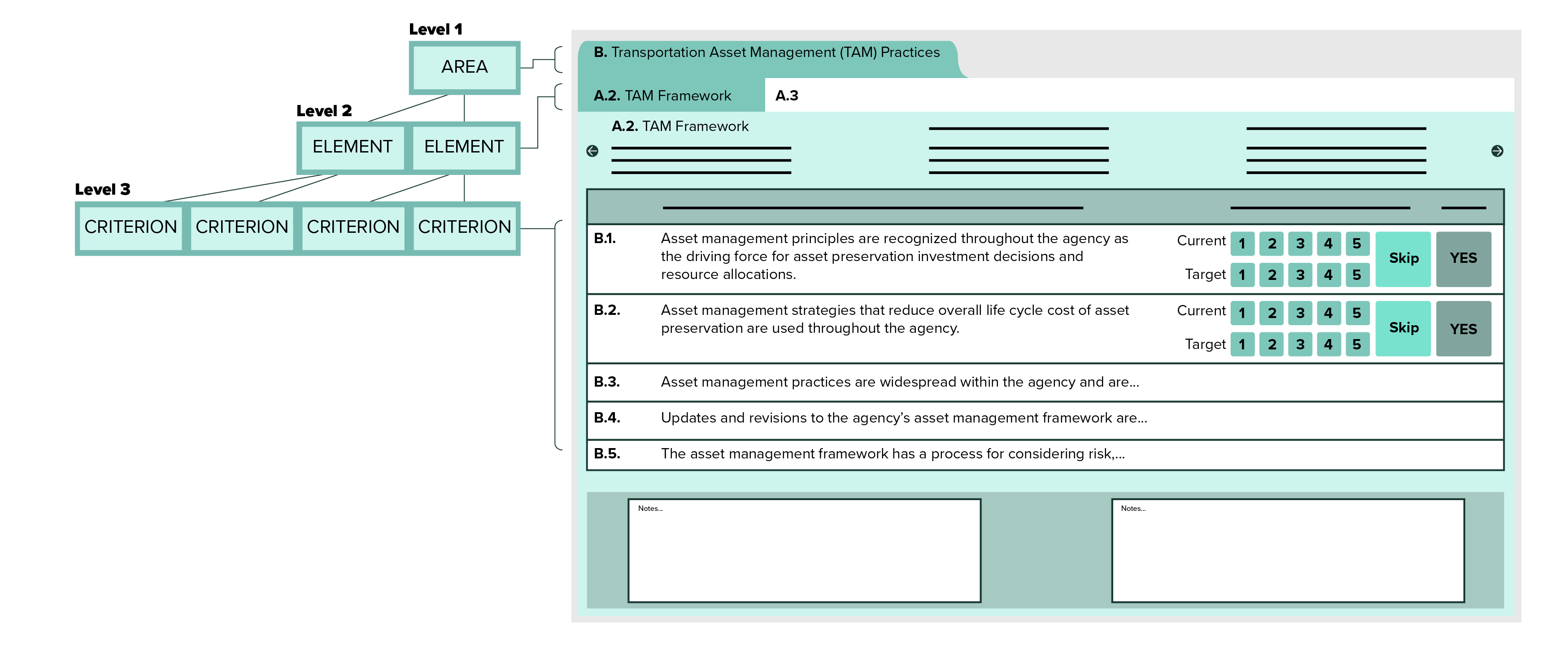- Chapters
-
Chapter 1
Sections - Chapter 1 Home Page
- Chapter PDF
Chapter 1
Quick Links
Section 1.4 NEW SECTION
TAM Gap Analysis Tool
The TAM Gap Analysis Tool enables agencies to self-assess their TAM practices to identify areas of strength and weakness. The results from the gap analysis provide useful information for:
- Comparing agency practices against strong industry practices.
- Identifying gaps between current and desired practices.
- Recognizing areas in which the agency is not performing at its desired level.
- Prioritizing action items for improvement plans.
- Monitoring advancements in TAM maturity over time.
Note: This section was derived from the AASHTO TAM Portal. The TAM Gap Analysis Tool, User Guidance, and additional information are available here: https://www.gapanalysis.tam-portal.com/sign-in/?next=/
TAM Gap Analysis Tool
The TAM Gap Analysis Tool enables agencies to self-assess their TAM practices to identify areas of strength and weakness. The results from the gap analysis provide useful information for:
- Comparing agency practices against strong industry practices.
- Identifying gaps between current and desired practices.
- Recognizing areas in which the agency is not performing at its desired level.
- Prioritizing action items for improvement plans.
- Monitoring advancements in TAM maturity over time.
Note: This section was derived from the AASHTO TAM Portal. The TAM Gap Analysis Tool, User Guidance, and additional information are available here: https://www.gapanalysis.tam-portal.com/sign-in/?next=/
- Chapters
-
Chapter 1
Sections - Chapter 1 Home Page
- Chapter PDF
Chapter 1
Quick Links
1.4.1
Gap Analysis Tool Data Structure
This subsection introduces the TAM Gap Analysis Tool designed for agencies to self-assess their Transportation Asset Management (TAM) practices. It outlines the tool's purpose, including comparing practices against industry standards, identifying gaps, recognizing areas for improvement, prioritizing action items, and monitoring TAM maturity over time. The tool operates at three levels—Assessment Areas, Assessment Elements, and Assessment Criteria—covering eight broad topic areas related to TAM practices, each with specific elements and criteria for evaluation during the gap analysis process.
Note: This section was derived from the AASHTO TAM Portal. The TAM Gap Analysis Tool, User Guidance, and additional information are available here: https://www.gapanalysis.tam-portal.com/sign-in/?next=/
Introduction
The Gap Analysis Tool supports analysis at three different levels as shown in the figure and described below.
Figure 1.6 TAM Gap Analysis Tool Demonstration
Level 1: Assessment Areas. The highest level is the Assessment Area, which includes eight topic areas:
- Policy goals and objectives.
- Asset management practices.
- Planning, programming, and project delivery.
- Data management.
- Information systems.
- Transparency and outreach.
- Results
- Workforce capacity and development.
Level 2: Assessment Elements.Each Assessment Area has been subdivided into two or more Elements, which can be considered subsets of each of the eight broad topic areas. The tool supports each element with general recommendations for agency practice improvement, and provides the option to share custom language to support agency user benchmarking decisions.
Level 3: Assessment Criteria. Within each Element, there are two or more criteria that are used to evaluate current and desired practice. Each criterion is presented as a standard statement representing good practice. The tool allows the assessment facilitator to adjust the criterion language as needed to promote understanding by the assessment participants.
During the gap analysis, participants evaluate how closely their agency’s practices match what is described in each criterion. This rating is considered representative of the agency’s current practices. Agencies may also define how closely they want to reflect the practices described in each criterion. This rating represents the agency’s desired practices. The difference between the current and desired practices determines whether a gap exists.
The number of Elements and Criteria within each of the eight Assessment Areas are shown in the table below.
Table 1.1 Assessment Areas of TAM GAP Analysis Tool
| Assessment Areas | Proposed Elements and Number of Criteria |
|---|---|
1: Policy Goals and Objectives |
|
2: Asset Management Practices |
|
3: Planning, Programming, and Project Delivery |
|
4: Data Management |
|
5: Information Systems |
|
6: Transparency and Outreach |
|
7: Results |
|
8: Workforce Capacity and Development |
|
- Chapters
-
Chapter 1
Sections - Chapter 1 Home Page
- Chapter PDF
Chapter 1
Quick Links
1.4.2
Using the Tool
This subsection introduces the TAM Gap Analysis Tool designed for agencies to self-assess their Transportation Asset Management (TAM) practices. It outlines the tool's purpose, administration process, and the flexibility it offers in tailoring assessments to agency needs. Additionally, the document provides a checklist suggesting strategies for addressing identified gaps and advancing agency practices based on the gap analysis results across different TAM focus areas.
Note: This section was derived from the AASHTO TAM Portal. The TAM Gap Analysis Tool, User Guidance, and additional information are available here: https://www.gapanalysis.tam-portal.com/sign-in/?next=/
Overview
A gap analysis is administered by an individual within the agency who is responsible for identifying participants, determining what part of the assessment each participant will receive, distributing links to the assessment to each participant, and compiling the results. As detailed in the User’s Guide, the TAM Gap Analysis Tool provides agencies flexibility in using the survey as it’s designed, or reducing the survey length by eliminating Elements or Criteria that may not be relevant. There is also flexibility in determining which parts of the assessment are appropriate for each participant. For instance, individuals associated with data collection may only be asked to evaluate the criteria related to Assessment Area 4, Data Management.
Individualized links are distributed to each participant to complete the assessment. Assessment participants are required to log into the web-based tool (using their email address). Once logged in, the participants are able to access the assessment, where they are asked to rate the agency’s current practices in comparison to each Criterion using a 5-point rating scale. Optional fields are provided for notes that a participant may want to make to explain their response. In addition to rating the agency’s current practices, the tool allows the agency to set a desired, or targeted, rating for each criterion using the 5-point scale.
After all assessments are completed, the results are compiled and presented as graphs, spider diagrams, and tables. Results can be compiled at the agency level or by any subset of the raters. Results can also be presented at the Assessment Area, Element, or Criteria level depending on the agency’s needs. To facilitate reporting, results can also be exported in spreadsheet format for external reference and use.
Additional details on administering the assessment and interpreting the results are available in the User Guide: https://www.tamguide.com/wp-content/uploads/2023/10/GAP-Analysis-Tool-User-Guidance.pdf

